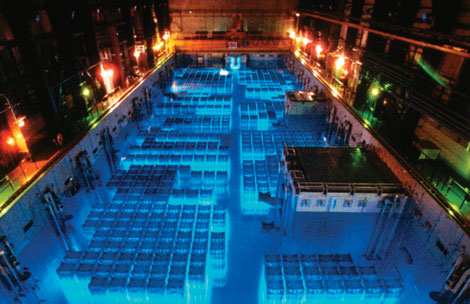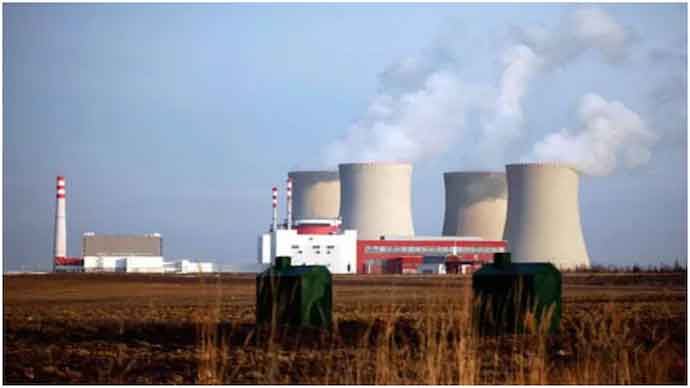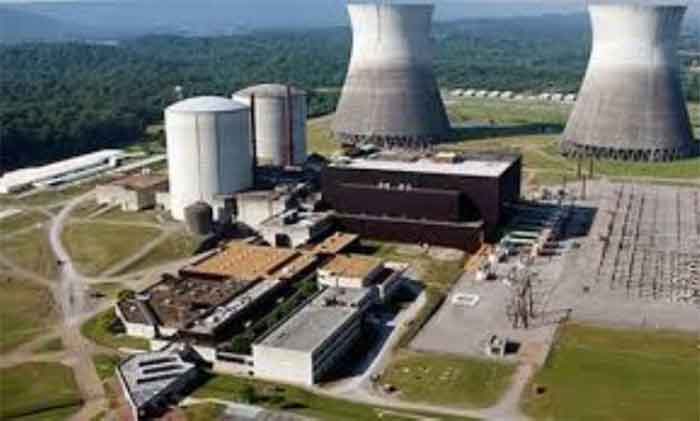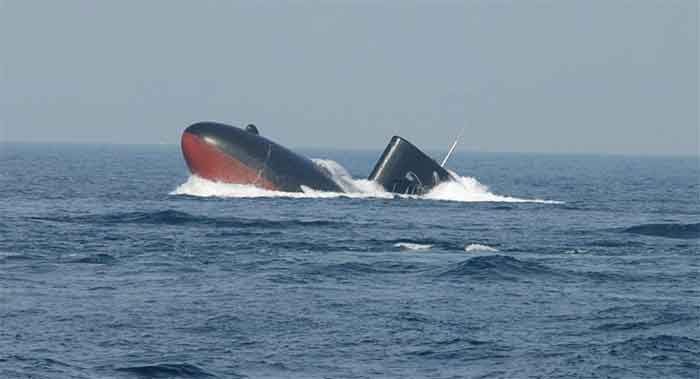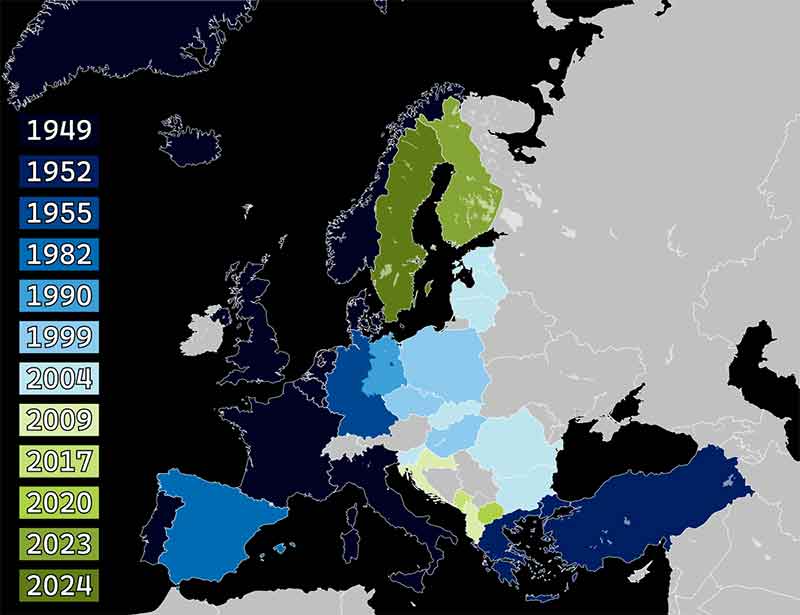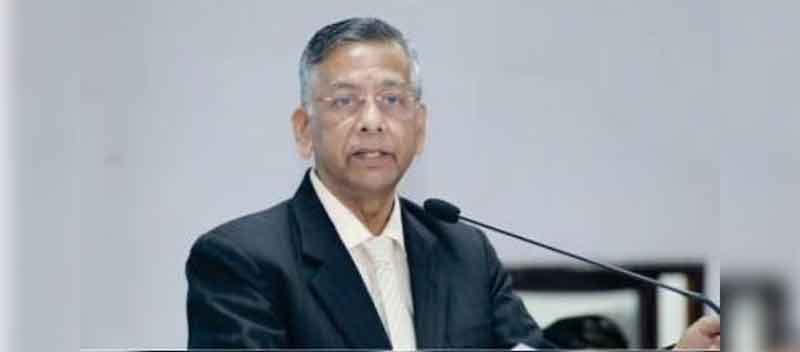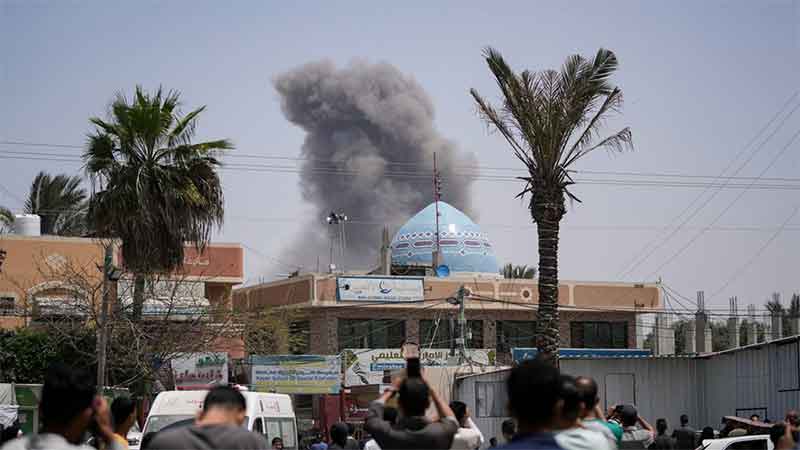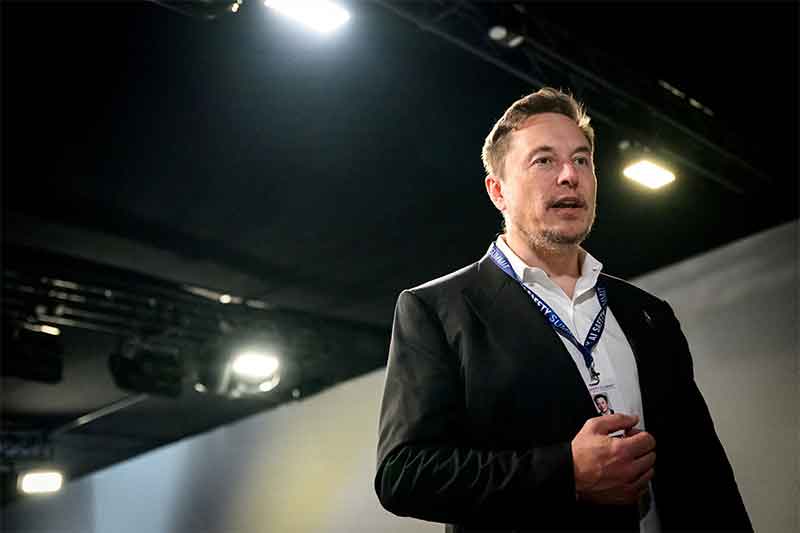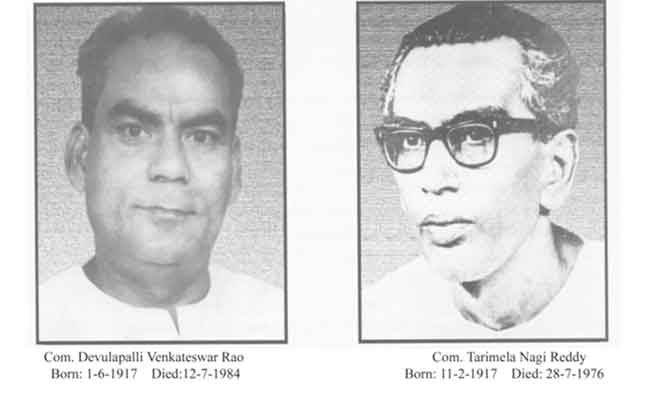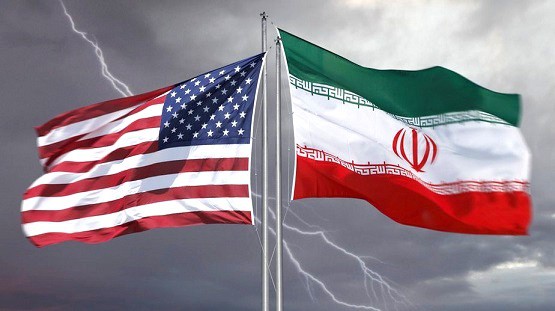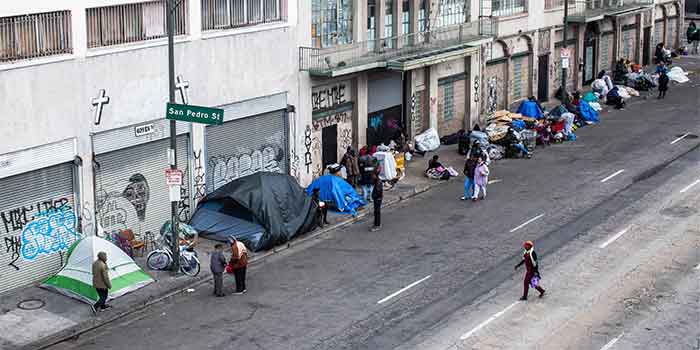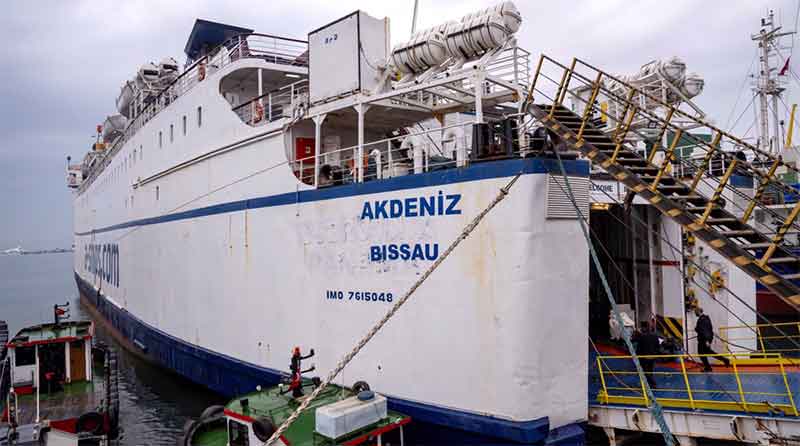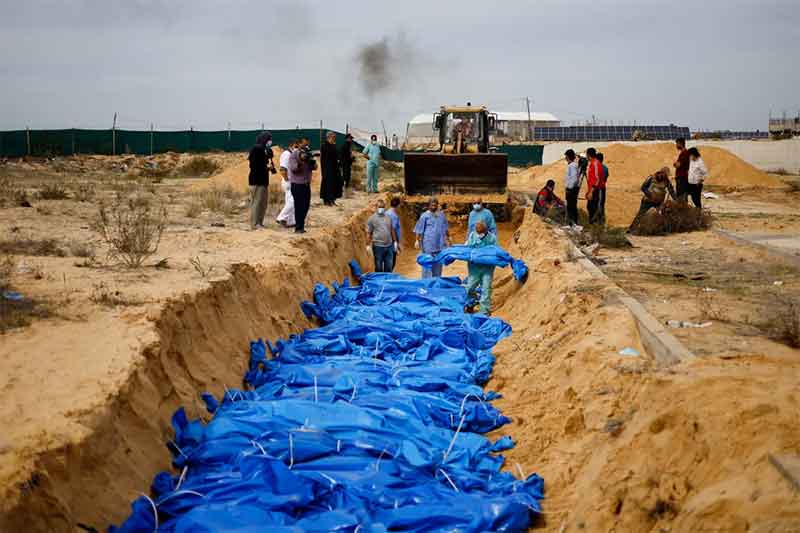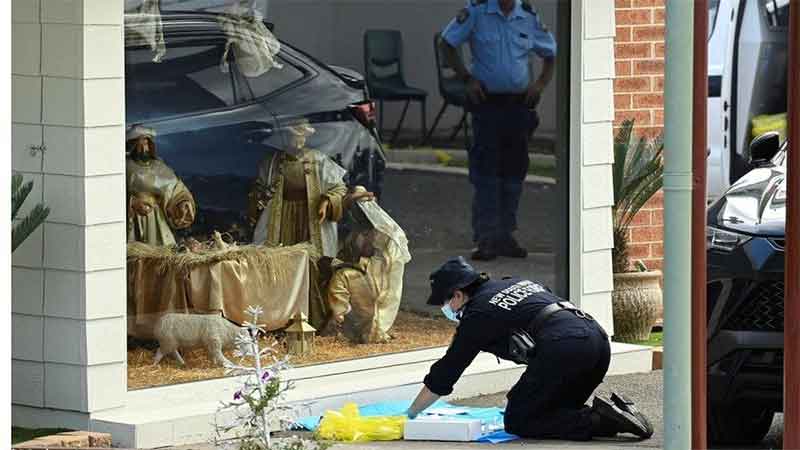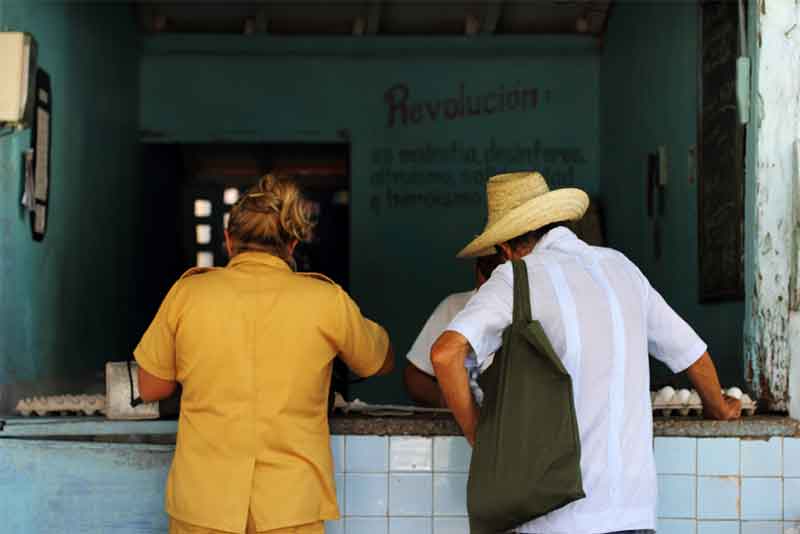Share:
Our planet is deeply burdened. It presently harbours 390,000 tons of high level nuclear waste produced by nuclear reactors and weapons programs over the past 70 years. Spent nuclear fuel is one of the most dangerous materials on earth. Most of it is stored underwater in numerous cooling ponds throughout the world. High level nuclear waste is dangerous to all life for unthinkable periods of time. Plutonium, which is produced in every nuclear fuel rod, has a toxic lifespan of 240,000 years. With each passing year, a further 10,000 tons of spent fuel is added to the world’s accumulated stores of deadly waste. In addition to the spent fuel from nuclear reactors, vast amounts of lower-level radioactive waste lie scattered in mining sites, tailings dams, undersea dumps and soil-borne contamination on every continent.
We have no idea what to do with the stuff. The Americans sank over $13 billion into the construction of a massive underground repository at Yucca Mountain in Nevada. It was closed down in 2010 without taking in a single gram of nuclear waste. The Soviets didn’t bother with such elaborate schemes and until recently, simply dumped much of their waste – including obsolete submarines complete with nuclear reactors – into the Kara Sea and elsewhere in the Arctic Circle where they slowly corrode, leaching their lethal contents into the cold waters of the Arctic Ocean.
In the meantime, a small cadre of aspirational Promethean technocrats in South Australia have somehow decided that Australia holds the solution to the global problem of nuclear waste. The recently released Nuclear Fuel Cycle Royal Commission Report recommends that the South Australian government accepts over one third of the world’s high level waste for above-ground storage and eventual burial in yet-to-be-built underground repositories in the South Australian desert. The report proposes that South Australia imports 138,000 tons of high level radioactive waste in the form of spent fuel rods as well as an additional 390,000 cubic metres of intermediate level waste for storage and eventual disposal.
This has all been spruiked as a fail-safe commercial venture that will relieve the South Australian Government of its financial problems ever after and create a rosy economic future for generations that have yet to be born. Such madness blithely ignores the fact that the genetic and biological futures of those generations may thereafter be a different story.
Awakening the Nuclear Beast
The cadaverous face of nuclear energy was revealed right from the start. Marie Curie, who discovered the radioactive elements radium and polonium, was fascinated with the peculiar luminosity emitted by the salts of uranium and radium. Her decades-long work with these elements was, however, invisibly accompanied by a slow and silent destruction of the blood-forming cells in her bone-marrow. This eventually led to her death from aplastic anaemia in 1934. Curie’s notebooks written over a century ago are stored in lead-lined boxes. Present-day researchers who wish to examine them are required to wear protective clothing.
The US military was among the first to realise the possibilities of glow-in-the-dark radium salts. Towards the end of World War I, it commissioned the painting of watch-dials and other instruments with radium. The idea became more widely popular and the United States Radium Factory was set up in New York in 1917. Over the following decade, 70 young women were employed to paint watch-dials with radium salts using fine camel hair brushes. They were instructed by their supervisors to keep the brush tips sharp by rolling them between their lips or on their tongues. Their inevitable fate is recounted in Eleanor Swanson’s powerful but harrowing poem The Radium Girls.
Ernest Rutherford’s work with uranium during the early years of the twentieth century led him to develop the first coherent model of the structure of the atom. Danish physicist Neils Bohr worked in his laboratory for a short time in 1912. Soon after, Bohr had refined Rutherford’s theory and formulated the idea that electrons moved in fixed orbits around a central nucleus and that, by absorbing or emitting energy, they could instantaneously change their orbits. His theory formed the core around which a more complete understanding of quantum mechanics could develop over the next decade.
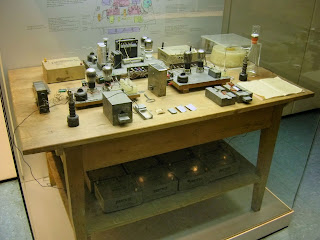 |
| Hahn and Strassmann. Tabletop Nuclear Fission Apparatus, 1938 |
Things then began to move very quickly. The development of particle accelerators enabled physicists to routinely transmute one element into another by the 1930s. In December 1938, the German chemists Otto Hahn and Fritz Strassmann observed that bombarding uranium with neutrons resulted in the formation of lighter, rather than the heavier elements that they expected. Hahn was mystified by the results and communicated the findings to his former colleague Lise Meitner who had taken refuge in Sweden because of Hitler’s anti-Jewish policies. She was visited soon after by her nephew Otto Frisch, a physicist at Neils Bohr’s laboratory in Copenhagen, and spoke with him about Hahn’s letter. In the discussions that followed, they realised that Hahn had unwittingly described the phenomenon of nuclear fission – the breaking apart of atoms of uranium. Together, they pieced together a plausible account of the process and submitted a short paper outlining their theory to the scientific journal Nature. It was published in February 1939.
The Human Chain Reaction
In the meantime, Otto Frisch had returned to Copenhagen and chanced to meet with his boss Neils Bohr, the early theorist of quantum mechanics. Bohr was just about to board a ship for New York City with a physicist colleague, Leon Rosenfeld. Otto Frisch later recalled:
“When I came back to Copenhagen, I found Bohr just on the point of parting, of leaving for America and I just managed to catch him for five minutes and tell him what we had done. And I hadn’t spoken for half a minute when he struck his head with his fist and said, “Oh, what idiots we have been that we haven’t seen that before. Of course this is exactly as it must be.”
As the ship steamed across the Atlantic, Bohr and Rosenfeld had ample time to reflect on the revolutionary news that Frisch had delivered. During those six days, they developed a detailed theory of the nature of nuclear fission. Otto Frisch in the meantime had confirmed that uranium atoms in fact were capable of dividing into smaller atoms with the release of large amounts of energy.
The Italian physicist Enrico Fermi, who was also among the new cadre of quantum theorists, was waiting on the pier when Bohr and Rosenfeld arrived in New York. Like many of his colleagues, Fermi had fled Europe because of the anti-Jewish policies of both Mussolini and Hitler and had taken up a position at Columbia University. Over the next few days, Bohr and Rosenfeld excitedly passed on this new revelation of the behaviour of uranium atoms to the close-knit group of elite physicists at Columbia and Princeton Universities. The implications were immediately understood by all.
These pivotal events in the early weeks of 1939 sent the world of physics into a fury of activity that culminated six years later in the detonation of the world’s first atomic bomb at Alamogordo in the New Mexico desert.
The Nuclear Chain Reaction
In the four months after Niels Bohr arrived in the US, the theoretical foundations for the creation of both a controlled nuclear chain reaction and a uranium-based weapon of unthinkable destructive power had been laid. Bohr and his colleagues were fully aware that after annexing Czechoslovakia in March 1939, Adolph Hitler had immediately seized the uranium mines at Joachimsthal and prohibited the export of uranium ore to any other country. They also knew that German physicists were actively engaged in atomic research.
More than 100 nuclear physicists left central Europe between 1933 and the early 1940s because of Hitler’s policies. Most of them ended up in universities and laboratories in England and America. They, together with their newly-found colleagues, quickly put the dots together. Soon after, a small group of expatriate European physicists persuaded Albert Einstein to sign a letter addressed to Theodore Roosevelt. In it, Einstein called for the immediate acquisition of uranium in large quantities and also for the development of a vigorous research program into both nuclear power and nuclear weapons. The letter, dated August 2nd 1939, stated:
“In the course of the past four months it has been made probable . . . that it may become possible to set up a nuclear chain reaction in a large mass of uranium, by which large amounts of power and vast quantities of new radium-like elements would be generated. Now it appears almost certain that this could be achieved in the immediate future.
This new phenomenon would also lead to the construction of bombs, and it is conceivable – though much less certain – that extremely powerful bombs of a new type may be constructed. . . . In view of this situation, you may think it desirable to have some permanent contact maintained between the Administration and the group of physicists working on chain reactions in America.
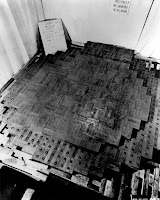 |
| Chicago Pile-1, layer 17 |
Three years later, Enrico Fermi and his group at the University of Chicago succeeded in their efforts to produce a controlled nuclear chain reaction. The world’s first nuclear reactor, named Chicago Pile-1 consisted of 40 tons of uranium oxide and 6 tons of uranium metal fashioned into 22,000 cylindrical slugs embedded in 380 tons of highly-purified graphite. Chicago Pile-1 went critical on the afternoon of December 2nd 1942.
As soon as the sustained nuclear reaction had been confirmed, Arthur Compton, the head of the Chicago laboratory, called his colleague James Conant, fellow physicist and director of the National Defense Research Committee in Washington. He cryptically reported: “The Italian navigator has landed in the new world.” Conant inquired, “How were the natives?” Compton replied “Very friendly.”
In the intervening decades, we have come to learn that the natives are not so friendly after all.
First Fruits
It was soon after confirmed – as Fermi had predicted – that the controlled fission in Chicago Pile-1 produced a new element, plutonium-239 in significant quantities. Plutonium promised to be even more fissionable, and hence more suitable for creating an atomic bomb, than the uranium-235 that physicists in the U.S. and the U.K. were hastily attempting to extract from uranium ores. The separation of uranium-235 tested the ingenuity of physicists on both sides of the Atlantic. But within three years of Fermi’s kindling of the first atomic fire at Chicago, both fissionable uranium and plutonium had been produced in sufficient quantities to construct three nuclear bombs.
The first was successfully detonated in the Trinity test at Alamogordo in the New Mexico desert on the morning of July 16th 1945. The second, a uranium bomb similar to the first, was dropped on the city of Hiroshima three weeks later. Three days after that terrible event, the world’s first plutonium bomb was ruinously “tested” on the people of Nagasaki. In those two atomic lashings visited on the people of Japan, 200,000 lives were vaporised by the unearthly infernos that erupted from the fissioning of less than two kilograms of heavy metal.
So as not to lose the edge that it had thereby gained, the U.S, military set about creating stores of plutonium as a matter of urgency. And nuclear reactors were now a ready means of producing virtually limitless supplies of this new element. The US military was not, however, alone in its aspirations.
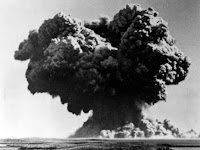 |
| First UK Atomic Bomb Test. Montebello Islands, Australia, 1952 |
The Soviets built their first nuclear reactor in 1946 using confiscated German uranium. In August 1949, they detonated their first atomic bomb. Its core consisted of plutonium. By 1951, the U.K. had built four nuclear reactors. On October 3rd 1952, the U.K.’s first atomic bomb was successfully tested in the Montebello Islands off the West Australian coast. It too was a plutonium device. By that time it was clear to all who coveted such power that nuclear reactors were essential for the creation of new arsenals of atomic weapons.
Thus were the beginnings of the nuclear age.
Catching Butterflies With Sledgehammers
A strategy was needed to redeem these technologies of death and make them more acceptable to the general public. Under the rubric of Atoms For Peace, U.S. President Dwight D. Eisenhower addressed the United Nations General Assembly in December 1953. In his carefully-crafted speech, Eisenhower launched the idea of creating an International Atomic Energy Agency that would oversee the development of a global nuclear power industry. He thereby initiated a soft sell that would, by 2016, see the world populated with 444 nuclear power plants in over 30 countries, with a further 63 reactors in the pipeline.
Nuclear reactors do not generate electricity. They generate ferocious amounts of heat, and that heat is used to produce steam that then drives powerful turbines. Nuclear reactors do, however, generate immense quantities of highly radioactive materials that are lethal to all forms of life. These materials must be kept isolated from living ecosystems for geologic periods of time because of their inherent dangers. These dangers were clearly understood long before the first commercial nuclear power plants began to appear in the late 1950s.
Within two years of Eisenhower’s Atoms For Peace speech, a conference on the disposal of radioactive wastes was organised at Princeton University in New York. It was attended by an elite group of physicists, nuclear engineers and representatives of private companies. Its purpose was to both address the growing problem of radioactive wastes from the U.S. nuclear weapons program, and to anticipate the consequences of the future deployment of large numbers of commercial nuclear power plants, each of which would produce dangerous wastes as a result of their operation.
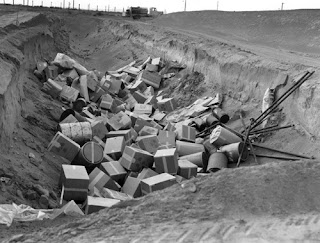 |
| Nuclear Waste Disposal, Hanford, 1950 |
The gravity of the waste problem was made clear to the group even during its first meetings in 1955, and was acknowledged within the first few paragraphs of the conference report: “The hazard related to radioactive waste is so great that no element of doubt should be allowed to exist regarding safety.” (p. 3) Later, Harry H. Hess, the conference chairman was to state:
“The waste we have on hand is not being disposed of, in any strict sense, and it is something to worry about. . . . For the immediate future, extending to many years, wastes will constitute a serious problem.” (p. 75)
Regardless, the dark horse of nuclear power was deemed ready to be set free and to gallop where it would through the steadily thickening airs of the twentieth century.
The Great Impasse
Participants at the conference agreed that arrangements should be made as a matter of urgency to develop and implement a program for the disposal of nuclear wastes in abandoned salt mines and deep salt beds. Vast deposits of bedded salt were known to exist along the southern edge of the Great Lakes extending from New York state to Michigan. Other potentially suitable sites were nominated in the Gulf states of Texas and Louisiana, and also in Utah, Colorado and Kansas. The conference also recommended that concurrent research be undertaken to find ways of stabilising nuclear wastes in the form of ceramics or insoluble slag.
Yet a curious inertia permeated the U.S. nuclear establishment. It took a further 45 years before the first (and only) functioning underground nuclear waste depository was actually constructed. The safe disposal of radioactive wastes was clearly not as straightforward as many had assumed.
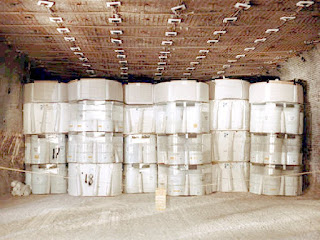 |
| Stacked Drums of Transuranic Wastes. WIPP, New Mexico |
The Waste Isolation Pilot Plant (WIPP) in New Mexico was built in a deep underground salt deposit and eventually opened in 1999 after years of contention between Federal and State regulators. The WIPP does not actually house any wastes from commercial nuclear reactors. It was specifically assigned to store the extremely long-lived transuranic wastes – which include large quantities of plutonium produced by the U.S. military nuclear weapons program between 1944 and 1988.
The WIPP repository has not been without its problems. In February 2014, a deflagration reaction within one of the barrels containing radioactive waste caused an intense fire that consumed the contents of the barrel. This resulted in the release of radioactive contamination throughout the underground tunnel system and into the surrounding environment. Above-ground monitors soon after detected the spread of radiation one kilometre away from the site of the fire. Waste storage operations were shut down immediately after the incident but are slated to resume in December 2016. The clean-up cost is already in the hundreds of millions of dollars.
More recently, doubts have been raised regarding the ultimate suitability of salt mines and salt domes as safe storage sites for radioactive wastes. Water has been found flowing through what were earlier believed to be impermeable salt deposits. This has certainly been the case in Germany’s Asse II underground salt chambers in which over 100,000 barrels of low to medium level nuclear wastes have been stored from the 1960s. The unexpected of water into these chambers has raised fears of longer term radioactive contamination of local groundwater.
In the meantime, most of the 70,000 tons of spent fuel in the U.S. continues to quietly glow in cooling ponds located alongside nuclear power plants. Many of these cooling ponds have reached their storage capacity with some 20% of the spent fuel stockpile having been transferred to above-ground dry storage casks. The situation is similarly fraught in Canada, the U.K., continental Europe, Russia and the Ukraine, China, Japan, Korea and many other countries where nuclear wastes continue to accumulate even as new reactors are commissioned.
Resuscitating a Nightmare
It is a curious thing to observe the confidence with which the recent Nuclear Fuel Cycle Royal Commission has embraced the promotion of South Australia as the ideal destination for over one third of the world’s accumulated stores of spent nuclear fuel. This spent fuel, together with the 400,000 cubic metres of intermediate-level nuclear waste that the Royal Commission recommends be transported to South Australia, represents a problem that nations with decades-long histories of nuclear energy production have failed to resolve. The entrancement induced by a whiff of billions of dollars of new revenue presently has a closed circle of nuclear advocates and politicians straining to persuade the people of South Australia to obligingly make their way as latter-day lemmings towards a dangerous and uncharted nuclear abyss.
In the short term, the Commission calls for the transportation of vast tonnages of highly radioactive materials from around the planet for decades-long storage in above-ground facilities. In the longer term, it proposes the construction of a deep underground repository for the “permanent” burial of the most dangerous wastes produced by a destructive and senescent civilisation.
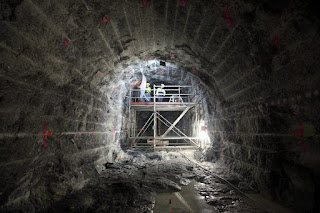 |
| Onkalo. Nuclear Repository Under Construction |
The pursuit of projects such as that envisioned by the South Australian Royal Commission has been plagued by unanticipated complications as has been shown at both the WIPP repository in New Mexico and Yucca Mountain in Nevada. The Onkalo spent nuclear fuel repository at Olkiluoto in Finland has been held up as the gold standard in nuclear waste repository design, but at the present time it remains an idea that has yet to be tested. The repository has been under construction since 2004 and is expected to open in the 2020s. It will eventually cost around $5 billion and is designed to store 5,000 tons of spent fuel from Finland’s four nuclear reactors for a period of at least 100,000 years. Meanwhile, Finland’s nuclear program continues to expand with a fifth reactor under construction and another on the drawing board.
Quo Vadis?
The project to bury the world’s nuclear poison in the heart of the Australian desert has not sprung out of a void. It is an idea that has been insidiously festering for two decades in a variety of incarnations. The first stirrings of the hellish project to turn Australia into the world’s nuclear dumping ground emerged in the late 1990s when Pangea Resources, a U.K. based company promoted the construction of a commercially-operated international waste repository in Western Australia. The project was supported by a $40 million budget, 80% of which came from British Nuclear Fuels Limited (wholly owned by the U.K. government), with the remaining 20% from two nuclear waste management companies.
That particular project came to an abrupt halt in 1999 after Friends of the Earth in the U.K. came into possession of a promotional video produced by Pangea Resources and sent it on to its sister organisation in Australia. The project did, however, excite the imagination of a number of prominent Australian politicians including former prime ministers Bob Hawke and John Howard. In 2005, Bob Hawke excitedly proclaimed: “Forget about current account deficits . . . we could revolutionise the economics of Australia if we did this.”
The situation is no different today. Current Prime Minister Malcolm Turnbull and opposition leader Bill Shorten seem to be in lock-step regarding the desirability of importing the world’s high level nuclear waste into South Australia. Neither has listened to the voices of indigenous traditional owners or of the more informed advocates of restraint and sanity.
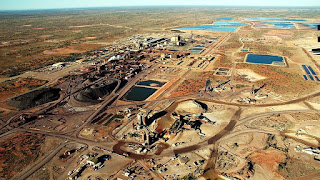 |
| Olympic Dam Uranium Mine, South Australia |
One of the more disturbing elements of the Royal Commission report is its explicit endorsement of the progressive nuclearisation of the planet over the course of the next century. But given the make-up of the Royal Commission, this comes as no surprise.
The fact that the earth presently heaves under the detritus, the violence, and the unquenchable excesses of a terminally destructive civilisation blind to its own approaching convulsions has simply not entered the consciousness of those who would sell the future for a mess of pottage. The projections of the Nuclear Fuel Cycle Royal Commission report are prefaced on the assumption of continuing social, political, economic, climatic and existential stability for the next 120 years – which is the nominated life-span of the project – and continuing geological stability for tens of thousands of years thereafter.
At a time when our collective energies could be given over to creating the conditions that will bring to an end the excess and wastefulness that have brought us all to such a perilous edge, we find ourselves being quietly goaded into a more-of-the-same, business-as-usual entrancement that ignores the realities we presently face and those that await our children and their generations. One can only hope for a general awakening whereby people everywhere will come to recognise the deceits, the distractions and the seductions perpetrated by those who would move the world the way it goes.
It has been said that the beginning of a situation holds the seeds of its future fruition. The will to power and the disregard of consequence that were made manifest by the destruction of Hiroshima and Nagasaki has already borne the dreadful fruits of Three Mile Island, Chernobyl, Fukushima and worldwide radioactive contamination. Let us nonetheless continue to strive to find the will to live in ways that honour the delicacy of life, the sublime coherence of nature, and the mystery of the love that brings forth all beings.
The Pangea Story
The video clip below was produced by the Australian Broadcasting Commission in 1999. It offers a remarkable account of how the shadowy dealings of corporate entities acting in concert with governments can be brought to light and held to account by attentive vigilance and informed commitment.

